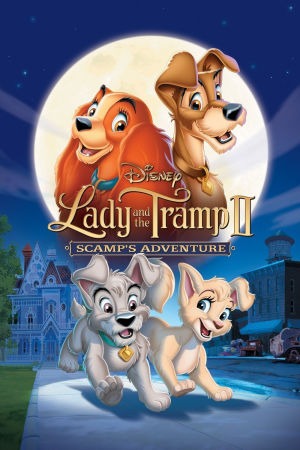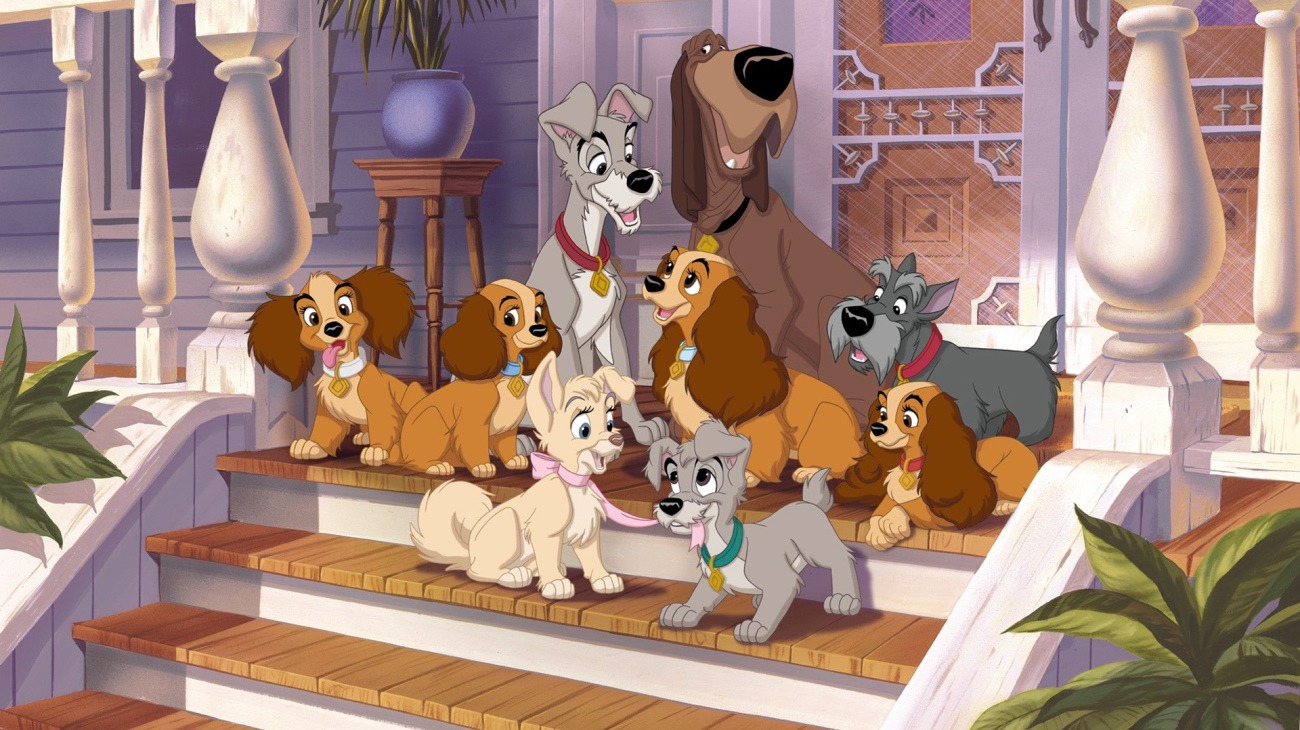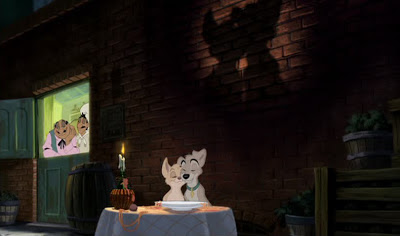
Disney Sequels: Repelled by all propriety
And now we go right over the edge.
Initially, the Disney direct-to-video sequels were horrible, mercenary, awful things that despite being horrible and mercenary, made sense: they were all based on recent hit films (no accident that the first two of the things were follow-ups to Aladdin, the first animated feature to ever crack $200 million at the U.S. box office alone), and could reasonably expect to capture a decent-sized portion of the child audience that made those films successful. Setting aside the Pooh videos as a special case, all of the DTV sequels produced from 1994 through 2000 were sequels to films of the Disney Renaissance of the 1990s; the longest gap was the eleven years between 1989's The Little Mermaid and 2000's The Little Mermaid II: Return to the Sea.
Then, right at the beginning of 2001, the bottom fell out, with Lady and the Tramp II: Scamp's Adventure, when the Disney executives made the horrifying discovery that they could cross-promote the re-releases on home video of their classics by tacking brand new sequels alongside them; and that is why the 46-year-old Lady and the Tramp abruptly found itself part of a franchise, one that was certainly not being sought by the world's legions of children who excitedly proclaimed that movie to be their all-time favorite Disney picture; because such children do not exist. Even in '55, Lady and the Tramp was a bit more grown-up skewing than the Disney norm, and while the appeal of talking dogs is universal and knows no age limit, I very much doubt that too many people in the target audience of Scamp's Adventure had overwhelmingly positive feelings about its predecessor.
All of which sounds like I'm being much harder on the film than I actually mean to: place of pride counts, and Scamp's Adventure deserves no mercy for being the first sequel to pre-'89 Disney feature - opening the floodgates that led to some truly notorious pictures such as the infamous Cinderella II: Dreams Come True, which is to be spoken of only in hushed tones in broad daylight, if it is to be spoken of at all - but that Rubicon was going to be crossed sometime or another, so it's not like it's exactly the "fault" of our present subject. Which, I am obliged to say, as I am an honest man, is not even all that bad. A screamingly unnecessary sequel that is not interested whatsoever in engaging with the film whose plot it nominally continues, for sure; a tepid bit of pandering to the kiddies with a barbarously on-the-nose moral, undoubtedly; an anonymous little adventure whose vanilla voice cast and stock situations admit no personality whatsoever, and whose thin, anodyne storytelling feels completely dislocated from its carefully-defined setting in the 1910s, without a hint of doubt. But it was - and this shocked the hell out of me - the best-animated of the Disney DTV sequels to that point, by an extraordinary margin; whatever nice, forced things I have managed to say about Beauty and the Beast: The Enchanted Christmas, or Pocahontas II: Journey to a New World, that is all forgotten now. Scamp's Adventure doesn't look good, plus a whole mountain of caveats; it simply looks good, like it's an honest-to-God animated movie, or something. I genuinely didn't realise that such a possibility was even on the table in this dark, scary journey through the Disney sequels, and my hat goes off to the Disney's Australian studio: they nailed this one.
None of which excuses the story and script: nothing could excuse this story, I reckon. For it is not a good story at all. But if you have the choice between a bad story in a movie that is ugly, or a bad story in a movie that is pretty, is that even a choice?
This story, about which I have such virulently bad feelings, picks up in the week prior to U.S. Independence Day, and therefore about six months and change after Lady in the Tramp, whose final scene was Christmas night. So the four children of prim cocker spaniel Lady (Jodi Benson) and charming mutt Tramp (Jeff Bennett) must be between seven and eight months old, and also horribly stunted mutants, because the puppies we see are clearly not big enough for that age, not even with cocker spaniel blood in them. The puppies in question are boy Scamp (Scott Wolf), who looks just like his dad, and the three sisters Girl Who Doesn't Matter 1, Girl Who Doesn't Matter 2, and Girl Who Doesn't Matter 3, who all look mostly like Lady, and strangely, though they are given neither names nor a narrative function, do manage to get distinct personalities: the shallow one, the prissy one, and the stupid one. I will concede a certain lopsided admiration for the degree to which Scamp's Adventure Does Not Give a Fuck about disguising the fact that it's designed to appeal squarely to boys, replacing the quiet romantic drama of Lady and the Tramp with a blank adventure story of a boy going out and being wild and all boy-ish, while the women in his life barely merit a mention - Lady herself is, at best, the fifth-most important character in the picture. This is, of course, something that happens in children's entertainment all the damn time, and it's ugly, but still, shamelessness has its own kind of seedy charm, and boy, is Scamp's Adventure ever shameless about this.
So the point is, anyway, that Scamp cannot but help looking around at his plush, upper-middle class lifestyle, and despise it with his very soul (genetic memory, or something). This puts him much at odds with Tramp - and I always took it to be that "tramp" was more of a title, a way of referring to a mysterious Dog with No Name, but here it is, getting used like it's no big deal at all - who has gotten very comfortable indeed and remembers his carefree days as a wild dog with fear and disdain, and who, for this reason, clamps down on his troublemaking son hard. Eventually, Scamp has enough, and uses the power of a musical montage to escape from the chain in the backyard where he has been assigned by the family's human contingent to think upon his sins; hereafter, he joins up with a pack of disreputable junkyard dogs fulfilling the "cornucopia of stereotypes" filled by the Dogs of All Nations in the pound in the first movie; but the only ones we need to worry about are Angel (Alyssa Milano), a girl dog about Scamp's size, and Buster (Chazz Palminteri), a Rottweiler who leads the junkyard pack, and nurses a deep hatred of Tramp for his betrayal in leaving the glorious life of a stray to pair up with that uptown bitch. This all seems entirely disproportionate to Tramp's actual sins - the only way to make sense of it at all is to assume that Tramp and Buster were lovers, which Disney would surely not want to be the assumption we make - but whatever. We need a villain, as good as the robust, energetic bad guy in the original Lady and the Tramp... right, that movie didn't have a villain. And is one of Disney's best films. Well, we get a villain anyway.
For a time, Scamp manages to hide his past, but both Angel and Buster learn, and have two very different reactions: she is angry that the pup would throw away the life in a loving home that is the secret wish of all Good Dogs, while the thuggish Rottweiler is ecstatic that he can now turn Tramp's son against him, in a particularly cruel revenge gambit. Meanwhile, Tramp and Lady, but mostly Tramp, are deeply anxious to find Scamp, whose absence has made the entire household, canine and human, incredibly sad. This all ends the way you'd expect it to: death and raw emotional pain. Or rather, everyone ends up back together and very special lessons are learned, of which the most urgent and obvious is: don't leave your cozy suburban house to join a gang. A fine lesson, but the film is bizarrely insistent upon it, in a way that very few Disney movies ever have an overt "message" - it's one direct address from Scamp to the camera away from being a full-blooded PSA.
All of that, of course, sucks; leastways, if it doesn't suck, it is certainly not very interesting (honestly, it's too banal to be truly objectionable), and while I can't fault it on the same grounds as the previous "child of the last movie's protagonist" DTV sequel, The Little Mermaid II, that Scamp is a botched character whom the story itself actively tries to make less interesting, the whole "angsty, rebellious kid just wants out from under his overprotective parents' thumb" plot is only fresh and invigorating the first couple dozen times you see it. And nothing about Scamp's particular presentation here is all that interesting, particularly with Wolf giving an anachronistically whiny teen spin on the performance that is quite unappealing in every register; it's enough to make Milano's non-presence as Angel seem almost compelling.
That's without even mentioning the film's disastrous low ebb, another musical montage in which Scamp and Angel realise that they are in love, while walking through the exact same landmarks that Lady and Tramp did in the last movie, right down to the spaghetti dinner, which is, by no stretch of the imagination, as beautiful and tender here as there. It's a peculiar and totally ineffective sop to the fans of the original that ends up paying off nowhere, given that the two dogs have had no particular romantic chemistry prior and do not share any afterwards, and it takes just a little bit of math to make it unbelievably creepy: at 8 months, Scamp is meant to be in his early teens, this seems quite obvious; Angel mentions having been in five human homes, until allergies or babies have driven her away, and even going miles out of our way to be generous, and saying that means three homes per year (which, given the speed at which human babies come along, one per year is probably closer to the mark), and giving some time for her to become an entrenched junkyard dog, means she's at least two years and then some. So this thankfully aborted love story is between a teen and a fully-grown adult (and no, dogs don't become "adults" like that; they also don't sing, talk, or have romantic candlelit Italian dinners), making it one of the statutory rapiest plots in all of Disney.
That is a large hole for the movie to dig itself out of. It can't get there all the way; but it sure does try. Part of this, as I've said - and a large part - is that the film looks great; not as good as what "real" Disney was up to at the same time (the bright, fizzy The Emperor's New Groove was just a couple of months earlier; the criminally under-realised but laudably ambitious Atlantis: The Lost Empire was the following summer), but a damned masterpiece by the standards of Walt Disney Television Animation, and I expect I would even say that it was good by the standards of non-Disney theatrical animation in 2001, except that by 2001 there was already not much 2-D animation happening out in America, and what little existed was in the main so cheap and thoughtless that it makes the comparison inappropriate. Also, Waking Life came out in 2001, and I would thus be proven wrong.
The point being: Scamp's Adventure looks really lovely, with crisp, clean lines, and a fair amount of character squeezed out of the drawings, and - and this is really the important part - a nice, smooth flow between images. None of the choppy, chintzy movements that have marked every single DTV sequel to this point! Scamp's Adventure looks, in fact, quite accomplished and artful, maybe not good enough to warrant a grown-up audience of grown-up animation buffs, but incomprehensibly far advanced from its stablemates. If it cannot replicate the greatest triumph of Lady and the Tramp - the dogs here act rather more like furry, four-legged humans than the actual animals that you might see every day of your life - well, we aren't here hunting for miracles, after all, and the fact that Scamp's Adventure moves cleanly and expresses emotion well is certainly far enough from the average that I see no reason to slag the movie for failing to be as zoologically focused as its predecessor.
(If there is one serious flaw, it's an over-reliance on obvious CGI everywhere: vehicles, fences, even a doggie door).
The other point in the movie, and not a hugely strong point, but we are perpetually in "any port in a storm" territory with these things, is the music: not the kind of thing that will fundamentally alter your relationship to film musicals, or any such thing, but tuneful as they go: co-written by singer-songwriter Melissa Manchester (not her first go-round with Disney; she provided a song to The Great Mouse Detective in '86) and Norman Gimbel, this is an extremely sensible, workmanlike set of songs, which do the thing workmanlike musical songs are meant to do: there's a big opening ensemble piece that sets the place (New England, as it turns out; I had always taken Lady and the Tramp to exist somewhere in the Lower Midwest, where Walt Disney himself came from), an "I Want" number, a big showstopper bit for the bad guys, a love ballad, and a tragic late "I Wanted" song, or whatever they're called, an epilogue. None of them are earworms, though I admire that the villains' number, "Junkyard Society Rag", makes an actual attempt to musically link itself to the time period being depicted, just about the only place outside of the production design where Scamp's Adventure remembers that it's 1911. Heck, even Lady and the Tramp - much less of a book musical than its sequel - doesn't have anything that particularly resembles period music. Also, none of them are in any way bad, and there is not a single rhyme that makes me want to crawl inside myself and die - a real triumph for the genre.
Am I giving Scamp's Adventure points merely because it isn't out-and-out bad? Hell yes, I am. These are the Disney sequels we're talking about, and I just survived The Little Mermaid II. Failing to be bad, even as it has a pointedly boring story and is so far removed from Lady and the Tramp in any emotional way that I don't know why they even bothered with the title, is enough to make anything look like a tiny masterpiece next to The Little Mermaid II.










